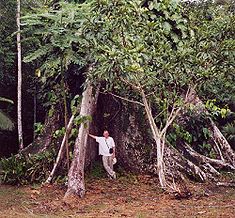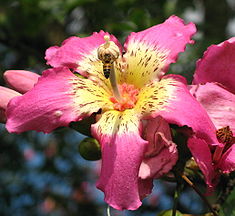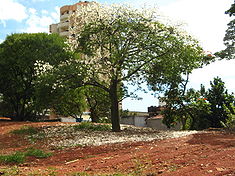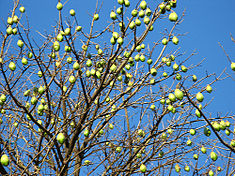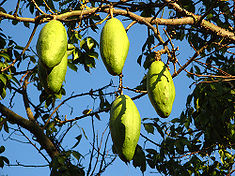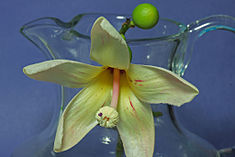- Ceiba
-
For other uses, see Ceiba (disambiguation).
Ceiba 
Ceiba pentandra leaves and fruit Scientific classification Kingdom: Plantae (unranked): Angiosperms (unranked): Eudicots (unranked): Rosids Order: Malvales Family: Malvaceae Subfamily: Bombacoideae Genus: Ceiba
Mill.[1]Species About 10-20 species, including:
Ceiba aesculifolia
Ceiba glaziovii
Ceiba insignis
Ceiba pentandra
Ceiba rosea
Ceiba speciosa
Ceiba trichistandraCeiba is the name of a genus of many species of large trees found in tropical areas, including Mexico, Central America, South America, The Bahamas, Belize and the Caribbean, West Africa, and Southeast Asia. Some species can grow to 70 m (230 ft) tall or more, with a straight, largely branchless trunk that culminates in a huge, spreading canopy, and buttress roots that can be taller than a grown person. The best-known, and most widely cultivated, species is Kapok, Ceiba pentandra.
Recent botanical opinion incorporates Chorisia within Ceiba, raising the number of species from 10 to 20 or more, and puts the genus as a whole within the family Malvaceae.
Ceiba species are used as food plants by the larvae of some Lepidoptera (butterfly and moth) species including the leaf-miner Bucculatrix ceibae which feeds exclusively on the genus.
Contents
In culture, history
The tree figures in the mythologies of pre-Columbian Mesoamerican cultures, in particular that of the Maya civilization, where the concept of the central world tree is often depicted as a Ceiba trunk, which connects the planes of the Underworld (Xibalba), the terrestrial realm and the skies. The unmistakable thick conical thorns in clusters on the trunk were reproduced by the southern lowland Maya of the Classical Period on cylindrical ceramic burial urns or incense holders. Modern Maya still often respectfully leave the tree standing when harvesting forest timber.[2]
The Honduran city of La Ceiba was named after a particular Ceiba tree that grew down by the old docks. The Puerto Rican town of Ceiba is also named after this tree. Ceiba is also the national tree of Guatemala.
In 1525, Spanish Conquistador Hernán Cortés ordered the hanging of Aztec emperor Cuauhtemoc from a Ceiba tree after overtaking his empire.
In 1898, the Spanish Army in Cuba surrendered to the United States under a Ceiba, which was named the Tree of Peace (Arbol de la Paz), outside of Santiago de Cuba.
Ceiba insignis and Ceiba speciosa are added to some versions of the hallucinogenic drink Ayahuasca.
Species
- Ceiba aesculifolia (Kunth) Britten & Baker, 1896
- Ceiba glaziovii (Kuntze) K.Schum., 1900
- Ceiba insignis (Kunth) P.E.Gibbs & Semir, 1988
- Ceiba pentandra (L.) Gaertn. - Kapok (The Caribbean, Central America, South America, West Africa)
- Ceiba rosea (Seem.) K.Schum., 1886
- Ceiba speciosa (A.St.-Hil.) Ravenna, 1998 - Palo borracho (Southern Brazil, Northeastern Argentina, Paraguay)
- Ceiba trichistandra Bakh., 1924[3]
Ceiba
Ceiba should not be confused with the vernacular name ceibo (Erythrina crista-galli), the national tree of Argentina and Uruguay.
See also
- Mesoamerican world tree
- Desert Garden Conservatory
- Parque de la Ceiba
References
- ^ "Ceiba Mill.". Germplasm Resources Information Network. United States Department of Aggriculture. 2003-06-05. http://www.ars-grin.gov/cgi-bin/npgs/html/genus.pl?2218. Retrieved 2009-10-13.
- ^ (BBC Earth News) "Sacred plants of the Maya forest", 5 June 2009 accessed 6 June 2009. Pachira aquatica and Pseudobombax ellipticum are also represented in the designs of similar ceramics.
- ^ "Subordinate Taxa of Ceiba". TROPICOS. Missouri Botanical Garden. http://tropicos.org/NameSubordinateTaxa.aspx?nameid=40003347. Retrieved 2009-10-13.
Wikimedia Foundation. 2010.

